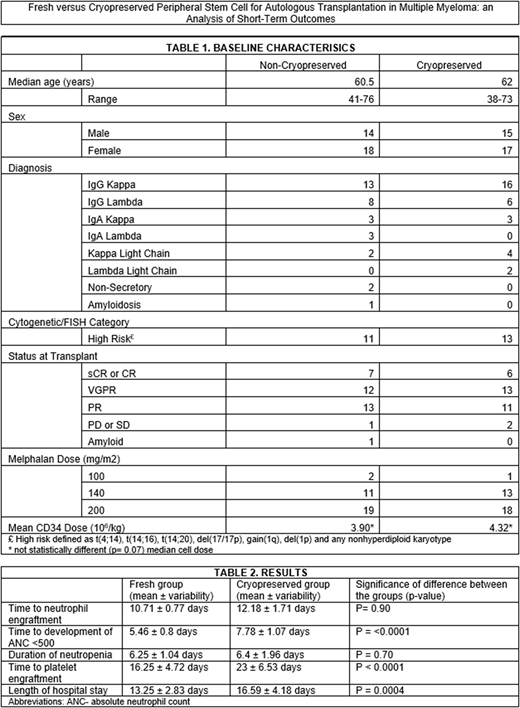BACKGROUND: The current standard practice in North America is to cryopreserve mobilized autologous stem cells for use after high dose chemotherapy for multiple myeloma. Fresh autologous stem cell infusions are used infrequently around the world for this same purpose with comparable efficacy.
This study aims to compare short term outcomes after autologous transplant with fresh versus (vs) cryopreserved (cryo) stem cells.
METHODS: Sixty-four (64) consecutive patients who underwent autologous stem cells for multiple myeloma at our center between June 2018 and December 2019 were grouped based on whether fresh or cryopreserved product was used for transplantation. The primary outcomes included the number of days until neutrophil and platelet recovery. The secondary outcome was length of hospital stay (LOS). After mobilization with G-CSF with or without plerixafor, peripheral blood stem cells were harvested over 1 day. For the fresh group, the collected cells were stored at 4 °C in the cell therapy laboratory for up to 48 hours. Meanwhile, the patient underwent high-dose melphalan treatment, 24 hours following which, the autologous stem cells were infused. In the cryopreserved group, the cells were cryopreserved for variable lengths of time until their infusion 48 hours after high-dose melphalan therapy.
RESULTS: Thirty-two (32) patients received fresh product and 32 received cryopreserved product. Baseline characteristics were similar between the groups and summarized in Table 1. Median CD34 count at infusion was 3.90 (range 2.83 to 5.68) million/kg in the fresh group and 4.32 (range 2.46 to 7.41) million/kg in the cryopreserved group, which was not statistically different (p= 0.07). Thirty patients in the fresh group and 27 in the cryo group received plerixafor. All the patients engrafted.
The median time to neutrophil engraftment was 11 days (range 10-13 days) in the fresh group compared to 12 days (range 10-18 days) in the cryopreserved group (10.71±0.77 vs 12.18±1.71 days. P= 0.90). ANC <500 developed earlier in the fresh group vs cryopreserved group at median of 5 vs 8 days respectively (5.46±0.8 vs 7.78±1.07 days. P = <0.0001) and the duration of neutropenia was not significantly longer (6.25±1.04 vs 6.4±1.96 days. P = 0.70). The median time to platelet engraftment was 18 days (range 14-21 days) in the fresh group versus 23 days (range 16-50 days) in the cryopreserved group (16.25±4.72 vs 23±6.53 days. P < 0.0001). The median LOS was 13 days (range 10-21 days) in the fresh group versus 17 days (range 13-30) in the cryopreserved group (13.25±2.83 vs 16.59±4.18 days. P = 0.0004).
CONCLUSIONS: Time to platelet engraftment and length of stay in the hospital were significantly shorter with use of fresh autologous stem cells compared to cryopreserved cell for transplantation for multiple myeloma. Despite earlier development of neutropenia in the fresh group, time to engraftment and duration of neutropenia were not significantly longer. CD34 cell dose was actually lower in the fresh group, with the difference approaching statistical significance.
The use of fresh autologous product is both feasible and safe. Early hematologic recovery, particularly in terms of platelet engraftment with use of fresh product has further helped with early discharge from the transplant clinic to the referring oncologists. It has also led to subsequent utilization of this approach in performing outpatient autologous transplants at our center.
Randolph:Bristol Myers Squibb, Celgene: Speakers Bureau. Khaled:Celgene, Seattle Genetics, Jazz, Takeda: Membership on an entity's Board of Directors or advisory committees, Speakers Bureau.
Author notes
Asterisk with author names denotes non-ASH members.


This feature is available to Subscribers Only
Sign In or Create an Account Close Modal